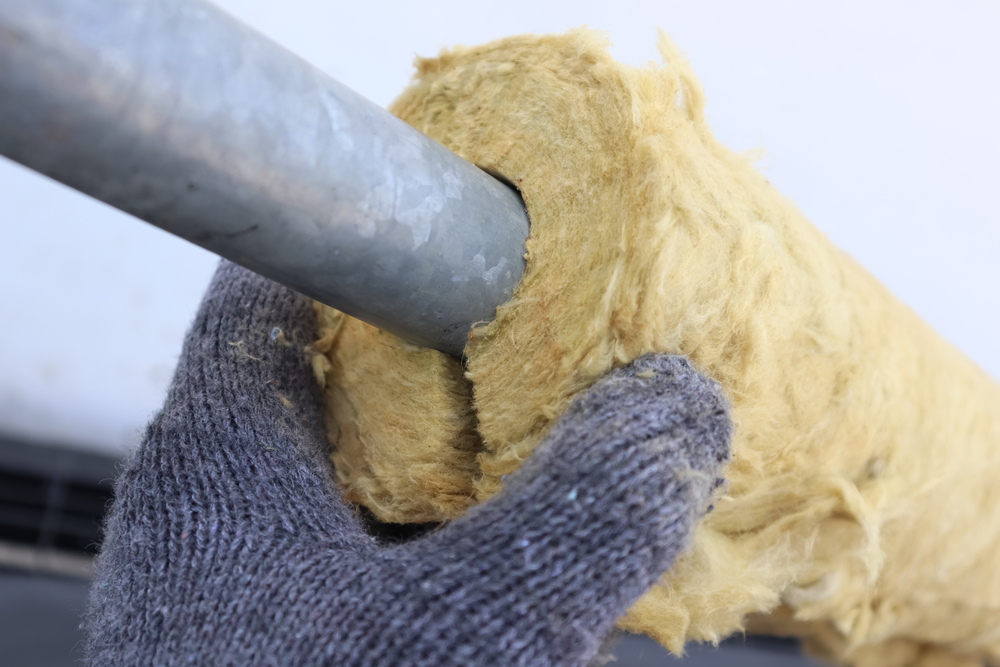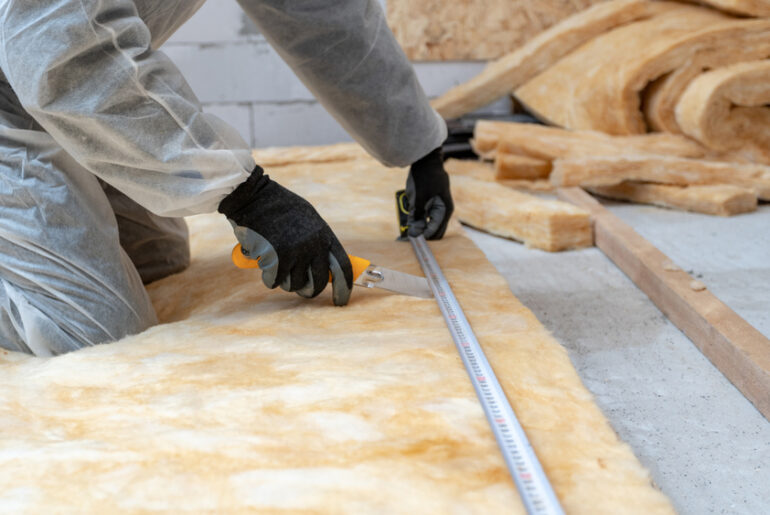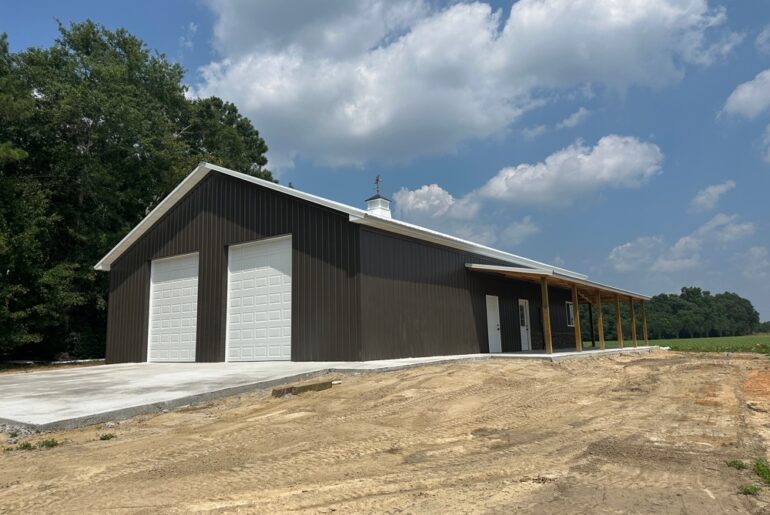Frozen pipes are no fun. Frozen pipes occur when below-freezing air comes into contact with a water-filled pipe, freezing it. Water expands when it freezes so the result is often a broken pipe.
Frozen pipes are easily avoided in most situations, but a careless mistake, like leaving a crawl space door open, can allow freezing air under your house. Open foundation vents can also cause frozen pipes, as can an under-insulated crawl space.
To avoid frozen water pipes, today we will discuss the process of insulating them using fiberglass insulation. Fiberglass insulation is cost-effective, easy to install, and prevents damage in very cold temperatures.
What is Fiberglass Insulation?
Fiberglass insulation is made from long strands of fiberglass, often arranged into a roll. These rolls, also known as batts, usually contain a paper vapor barrier as well but not in all cases. Several manufacturers offer fiberglass insulation batts in various sizes, materials, and designs.
Fiberglass insulation is available in a variety of lengths, widths, and thicknesses. R-value is determined by the thickness, which is usually about 3 ½” to 12”. Working with fiberglass insulation still requires precautions and attention to detail, but the insulation produced today is technologically superior to what was available just a few years ago.
For example, modern fiberglass insulation is safer to use than older versions of insulation. Fiberglass insulation produced prior to October 2015 may contain formaldehyde, a potentially harmful chemical. Modern fiberglass insulation does not contain formaldehyde or high concentrations of other harmful chemicals.
How Does Fiberglass Insulation Work For Pipes
Fiberglass insulation prevents a natural process known as thermal transfer. Translated, thermal transfer means allowing heated air to mix with cooler air. Fiberglass greatly reduces the thermal transfer of heat to cold, so it’s great for insulating pipes.
The fiberglass strands literally trap air inside the strands, which slows the thermal transfer. In effect, this means warm water flowing through your pipes stays warm until it reaches its destination instead of cooling off before it arrives. Adding insulation also protects the pipe from the ambient air, which can get below the freezing point.
Can You Put Insulation Around Hot Water Pipes?
You can use fiberglass insulation for all of your supply pipes, both hot and cold. Some people fear that installing fiberglass insulation around hot water pipes might cause them to get too hot.
However, all plumbing pipes are built to withstand much higher temperatures than the water they contain. Insulating the pipe can never cause an overheating problem because the insulation doesn’t add any heat.
Insulation only retains the heat already present, so if a pipe were to melt, for example, it would be caused by the temperature of the water, not the insulation. Fiberglass insulation also has a high ignition point so, by design, it doesn’t burn easily.
Can You Insulate Pipes With Fiberglass Yourself?
A do-it-yourselfer with a little experience can use fiberglass insulation to protect their pipes. In fact, insulating is a great first-time DIY project. Installing fiberglass insulation on pipes is simple and only requires a few common tools. You also don’t need to disconnect the water as you would if you were performing an electrical project.
What Safety Equipment Do I Need to Work With Fiberglass Insulation?
Basic safety precautions, like eye protection, gloves, masks, and ear protection (when appropriate) should always be used when doing work around the house. ALWAYS wear the safety gear appropriate for the job. In the case of fiberglass insulation, you’ll need an approved respirator, eye protection, and gloves.
Fiberglass strands are extremely light and become airborne very easily. Often, when insulating pipes you are in an enclosed space like a crawlspace. Air circulation is usually poor in these areas, so a respirator is required. Fiberglass strands are also easily embedded into the skin, so gloves will prevent much skin irritation.
What is Micro-Lok Pipe Insulation?
Micro-Lok pipe insulation is technologically advanced pipe insulation that uses a mixture of fiberglass strands and resin to form an effective, easy-to-install insulation. Micro-Lok insulation does not require tape because it includes a self-sealing overlap, which instantly bonds upon contact.
Micro-Lok is usually available in 36” lengths, as opposed to 48”, and offers a very wide range of applications. Micro-Lok can be used to insulate iron pipes, copper tubing, or plastic pipes. Micro-Lok can withstand very high temperatures, yet can be installed in very low temperatures, making it ideal in repair situations.
Which is the Best Fiberglass For Pipe Insulation?
All forms of fiberglass do a good job of insulating your pipes, but some are more effective and easier to use than others. Here we will describe the most common forms of fiberglass pipe insulation and the pros and cons of each:
Loose Fiberglass
Loose fiberglass is likely the most difficult pipe insulation material to work with. In years past, a common way to insulate galvanized steel pipes used loose fiberglass. In most cases, the loose fiberglass was wound around the pipe and secured with strapping tape, electrical tape, or even duct tape.
Using this method was effective, but it tended to have a short lifespan because the tape would dry out over a hot summer and fall off. Unfortunately, pipes are often in locations we don’t visit every day, so falling insulation may go unnoticed until it’s too late.
Working with loose fiberglass is also more involved because the fiberglass strands tend to become airborne. As a result, you must wear a respirator when working with loose fiberglass, as well as eye protection and gloves.
Fiberglass Pipe Wrap
Several companies manufacture fiberglass insulation suitable for use on pipes. Loose batting or even faced batting can leave the insulation exposed without protection, shortening both its life and effectiveness.
Using tape to secure fiberglass batting is usually avoided as well because it forces the air from the batting. Adding additional fiberglass will help, but a better solution is fiberglass pipe wrap, which is designed just for pipes.
Also known as a fiberglass sleeve, fiberglass pipe wrap is easier to install than loose fiberglass or fiberglass batting. Fiberglass pipe wrap fits the pipe better, offers more insulation value, and can be installed in minutes. However, fiberglass pipe wrap is more expensive than loose fiberglass or batts.
Fiberglass pipe wrap is sold in similar sizes to the pipes themselves so they fit better on the pipe. Fiberglass pipe wrap is pre-shaped so it doesn’t have to wind around the pipe, but is simply slipped on.
Because the pipe wrap slides on, the insulation isn’t crushed in the process. Plus, the seam in the insulation used to insert the pipe is designed to be sealed with one piece of tape, making the project fast. The backing is also typically more durable than fiberglass batts, which helps protect the insulation and make it last longer.
How to Install Fiberglass Pipe Insulation
Most fiberglass pipe insulation is installed in a similar fashion, so we will describe the typical steps involved. Depending on which solution you choose the steps may be slightly different, so follow the manufacturer’s instructions carefully.
The goal in using fiberglass insulation for pipes is to completely cover the pipe with as much insulation as possible without crushing it. Pipe insulation should be installed loosely because the goal is to trap as much air as possible within the fiberglass.
To be clear, we are primarily discussing insulating water supply pipes, but the process is similar for gas pipes as well.
1. Measure the Fiberglass Pipe Insulation
The first step in insulating a pipe is to decide how much insulation the project will require. Most fiberglass pipe wrap is available in increments of 36” to 48” and will include a flap on one end. This allows the backing to overlap the next section without making the insulation double thick where two sections meet.
If you are using loose fiberglass insulation, keep the fiberglass as fluffy as possible. Many contractors will purchase R-6 batting, but a higher R-value will also work. Most professionals use 12” batting, faced or unfaced, and split it into two long sections. Doing so results in two 6” wide sections, which is ideal for many pipe sizes.
2. Install the Fiberglass Pipe Insulation
To illustrate, let’s say we have an 8’ straight section of pipe with no elbows or tees. If we are using fiberglass pipe wrap, we will simply attach two 48” sections parallel to the pipe and tape them together, end to end.
Loose fiberglass is often used in pre-cut batt form, which means the insulation is already cut to length. Most batts are pre-cut for a wall, which is usually 96”-120”. You can either leave the batt the full length or cut it into more manageable sizes, but make sure every joint is sealed. In this example, a 96” batt could be split down the middle, resulting in 16’ of pipe insulation.
Pro Tip. Instead of winding the batting around the pipe, simply cut a section to match the length of the pipe and install it parallel to the pipe. This prevents overlapping the insulation while retaining most of the air in the fiberglass.
3. Use Insulation Tape
Next, completely cover the pipe making sure no pipe is exposed. Most fiberglass pipe insulation requires the use of special sealing tape designed for pipes so it will last longer. Known as seam tape or insulation tape, pipe insulation tape is often made from metal foil or fiberglass and is designed for better adhesion.
Masking tape, strapping tape, or duct tape should not be used to secure fiberglass pipe insulation. These tapes have their place, but securing fiberglass around a pipe isn’t one of them. Pipe insulation tape is very sticky, so be careful not to let it contact itself.
Because pipe tape has such strong adhesion, if two sections accidentally come into contact, you will destroy the tape attempting to pull them apart. Don’t worry if you need to work with a short section of tape. If this happens, just start over with a new shorter, more manageable length and try again.
Building codes often specify which tape can be used and for what purpose. For example, Nashua foil tape is standard for HVAC, bathroom exhaust vents, and dryer exhaust vents. You can also use it to secure fiberglass pipe insulation, but other products are available just for pipes. Some insulation tape actually includes additional insulation within the tape itself.
However, if in doubt, check with your local codes official. They are happy to help and may save you from doing the project twice. Especially in cold regions, building codes may require additional R-value or a specific method of taping, so it’s best to have the information before you start.
4. Work Around Joints
Eventually, you will probably come to a joint where the pipe changes direction or joins another pipe. Because the insulation is flexible, most pros will just split the insulation as needed with a utility knife, creating a 90-degree channel for a perpendicular pipe.
Next, they slide the insulation down the pipe, allowing the perpendicular pipe to slide inside the split in the insulation. Once the fiberglass is in place, pipe insulation tape is used to repair the split.
You can use this process over and over any time you encounter a joint, but be careful not to overlap the insulation. As mentioned earlier, the air inside the insulation is what provides the resistance to thermal transfer, not the fiberglass itself. Some people new to insulating might assume more insulation is better, but that isn’t necessarily the case if the air is expelled.
Insulating Pipes with Fiberglass is Simple and Effective
Some insulation is better than no insulation. Regardless of the method you choose, insulating your pipes is like buying cheap insurance. Repairing damaged pipes is a hassle and can be expensive, so in the case of pipe insulation, an ounce of prevention is worth a pound of cure.





